Last updated: May 8, 2023
Article
The Siege of Port Hudson: "Forty Days and Nights in the Wilderness of Death" (Teaching with Historic Places)
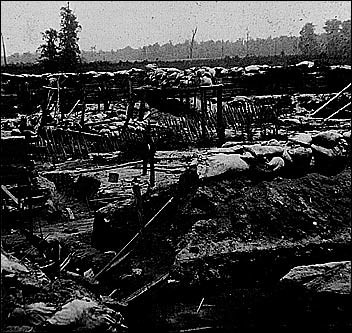
Confederate fort after the siege. (Massachusetts MOLLUS Collection, U.S. Army Military History Institute, Carlisle Barracks, PA)
This lesson is part of the National Park Service’s Teaching with Historic Places (TwHP) program.
We eat all the meat and bread in the fort...eat all the beef--all the mules--all the Dogs--and all the Rats around us.
So wrote a soldier who had been inside the Confederate defenses at Port Hudson, Louisiana, during one of the longest sieges in American military history. For 48 days in 1863, he and his fellow troops defended a fort that stood on top of a bluff above the Mississippi River; for all of those 48 days, Union soldiers pummeled the Confederates with cannon shot and rifle fire.
Finally, just five days after the Confederates were defeated at Vicksburg, Port Hudson surrendered to the Union. With these two victories, the North could finally claim undisputed control of the Mississippi River. Though the Civil War would rage on for almost two more years, the siege at Port Hudson, and the battles of Vicksburg and Gettysburg--which all occurred the same week--together struck a blow from which the South never recovered.
About This Lesson
This lesson is based on the National Register of Historic Places registration file, "Port Hudson Battlefield" (with photographs), and other primary sources about the siege. It was made possible by the National Park Service's American Battlefield Protection Program. The lesson written by Gregg Potts, Site Manager at the Port Hudson State Commemorative Area, and Arthur W. Bergeron, Jr., historian at Pamplin Park Civil War Site in Petersburg, Virginia. TwHP is sponsored, in part, by the Cultural Resources Training Initiative and Parks as Classrooms programs of the National Park Service. This lesson is one in a series that brings the important stories of historic places into the classrooms across the country.
Where it fits into the curriculum
Topics: The lesson could be used in units on the Civil War. Students will strengthen their skills of observation, research, and analysis of primary sources.
Time period: Late 19th century
United States History Standards for Grades 5-12
The Siege of Port Hudson: "Forty Days and Nights in the Wilderness of Death" relates to the following National Standards for History:
Era 5: Civil War and Reconstruction (1850-1877)
-
Standard 2A- The student understands how the resources of the Union and Confederacy affected the course of the war.
-
Standard 2B- The student understands the social experience of the war on the battlefield and homefront.
Curriculum Standards for Social Studies
(National Council for the Social Studies)
The Siege of Port Hudson: "Forty Days and Nights in the Wilderness of Death"
relates to the following Social Studies Standards:
Theme III: People, Places, and Environment
- Standard I - The student describes ways that historical events have been influenced by, and have influenced, physical and human geographic factors in local, regional, national, and global settings.
Theme VI: Power, Authority, and Governance
- Standard G - The student describes and analyzes the role of technology in communications, transportation, information-processing, weapons development, or other areas as it contributes to or helps resolve conflicts.
Theme VII: Production, Distribution, and Consumption
- Standard I - The student uses economic concepts to help explain historical and current developments and issues in local, national, or global contexts.
Theme VIII: Science, Technology, and Society
-
Standard A - The student examines and describes the influence of culture on scientific and technological choices and advancement, such as in transportation, medicine, and warfare.
-
Standard E - The student seeks reasonable and ethical solutions to problems that arise when scientific advancements and social norms or values come into conflict.
Objectives for students
1) To explain how the physical features of the area made Port Hudson strategically important for both sides.
2) To examine the particular characteristics of siege warfare and how it affected soldiers physically and mentally.
3) To determine if their own community has withstood monumental crises, and how it responded to such a situation.
Materials for students
The materials listed below either can be used directly on the computer or can be printed out, photocopied, and distributed to students.
1) two maps showing the Mississippi Valley and Port Hudson;
2) four readings about the siege, including several first-hand accounts from soldiers;
3) five historic photos made during the siege and after the surrender;
4) one illustration of African American troops at Port Hudson from Harper's Weekly;
Visiting the site
Port Hudson State Commemorative Area is located in East Feliciana Parish adjacent to the old town site of Port Hudson, Louisiana. The main entrance is located on U.S. Highway 61, approximately 15 miles north of Baton Rouge. Port Hudson State Commemorative Area is open from 9:00 a.m. to 5:00 p.m. year round, except New Year's, Thanksgiving, and Christmas. For more information, contact the Commemorative Area Manager, Port Hudson State Commemorative Area, 756 West Plains Port Hudson Road, Zachary, LA 70791.
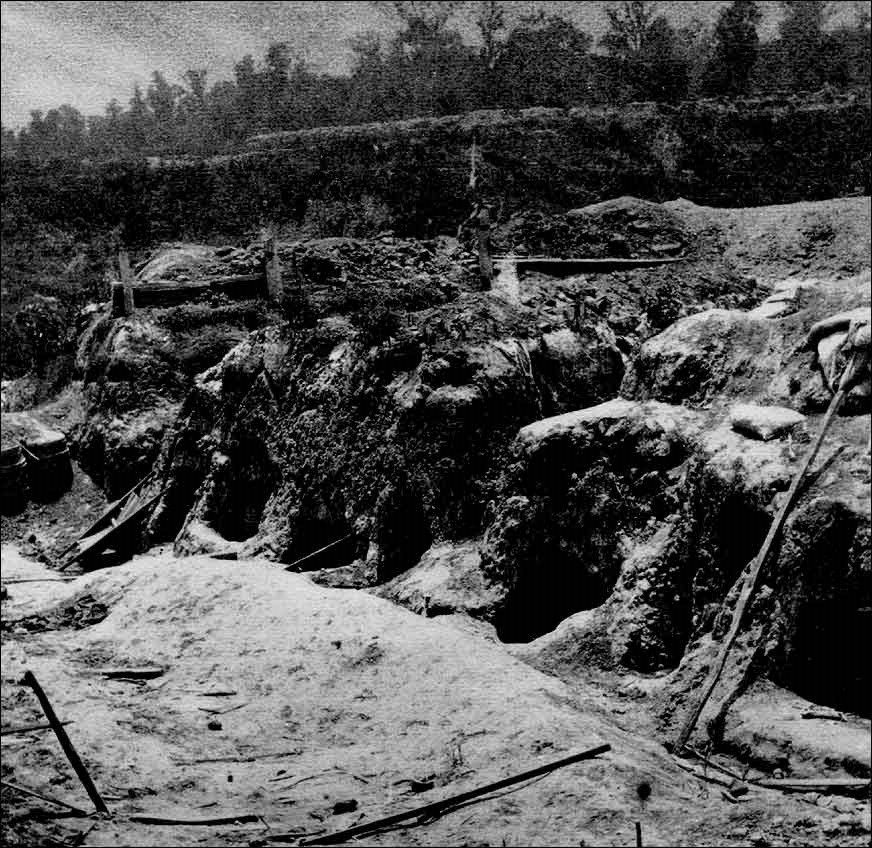
What might these be?
What do you think they were used for?
Setting the Stage
From the time the Civil War started in April 1861, both the North and South made controlling the Mississippi River a major part of their strategy. The Confederacy wanted to keep using the river to transport needed supplies; the Union wanted to stop this supply route and drive a wedge that would divide Confederate states and territories. Particularly important to the South was the stretch of the Mississippi that included the mouth of the Red River. The Red was the Confederacy's primary route for moving vital supplies between east and west: salt, cattle, and horses traveled downstream from the Trans-Mississippi West; in the opposite direction flowed men and munitions from the east.
In the spring of 1862, the Union took control of New Orleans and Memphis. To make sure it could continue to use the middle section of the river, the South fortified positions at Vicksburg, Mississippi and Port Hudson, Louisiana.
Locating the Site
Map 1: The Mississippi River Valley.
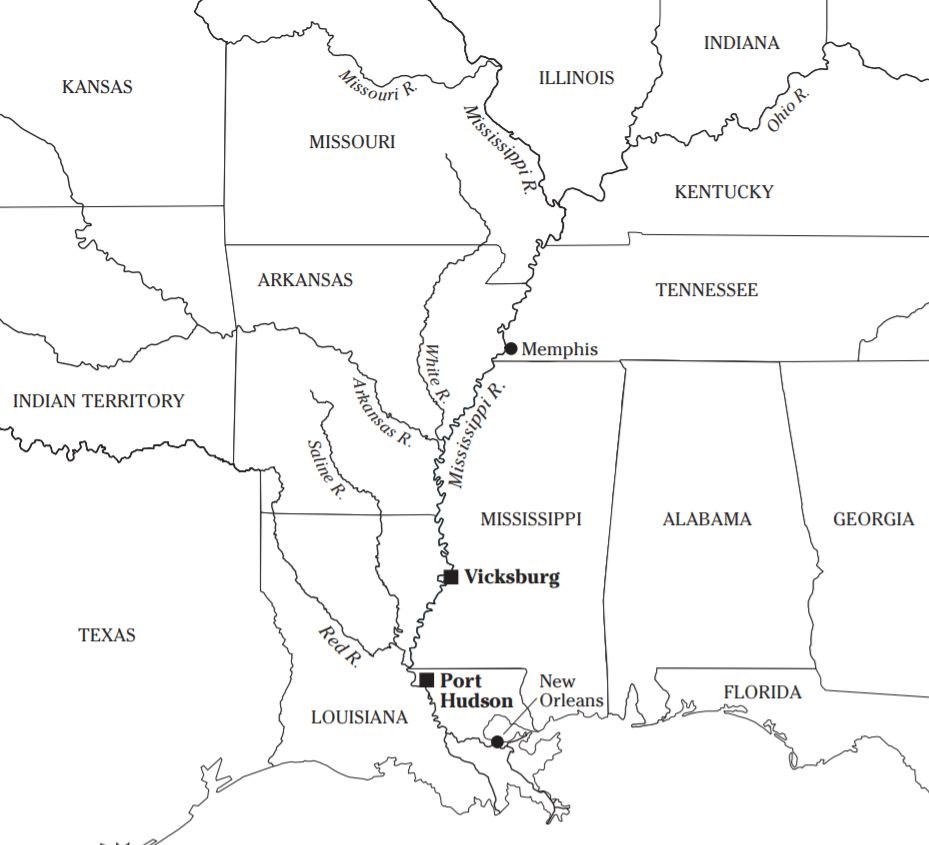
Questions for Map 1
1. Name all of the Confederate states that would be cut off if the Union gained control of the Mississippi.
2. Circle Vicksburg and Port Hudson on the map. Then trace the Mississippi where it runs between the two forts.
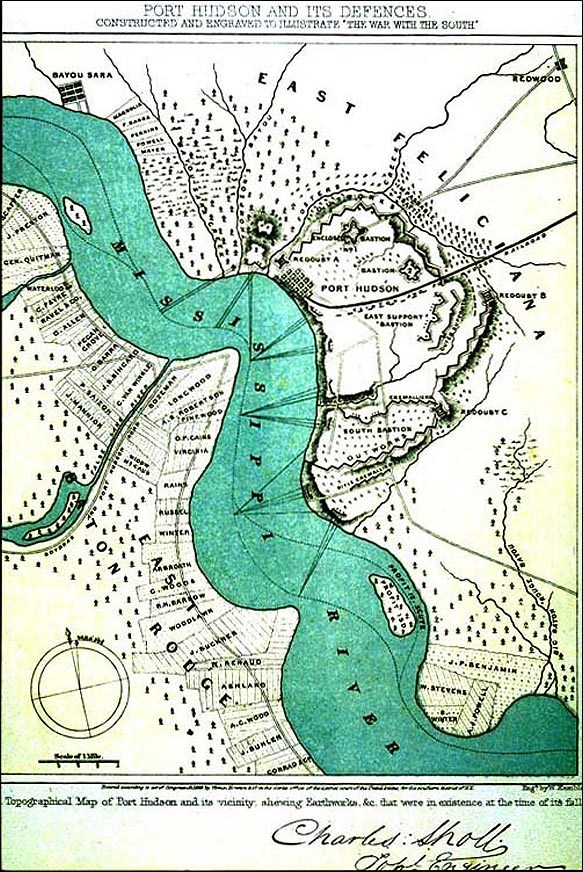
This topographical map of Port Hudson and its vicinity shows the earthworks and other defenses in existence at the time of its fall. The earthworks were dirt fortifications built by the Confederates, behind which they placed artillery and soldiers with rifles. Keep in mind that Port Hudson sat on an 80-foot bluff. Some of the ravines surrounding the Confederate defenses were as deep as 60 feet, and many streams and rivers protruded from the Mississippi all around the area. The bend in the river near Port Hudson made navigation both downstream and upstream a slow, painstaking process.
Questions for Map 2
1. What geographical features made Port Hudson a good place to establish a fort?
2. How do you think the Confederate army decided where to build its earthworks? Do they seem to have a strong defensive position?
Determining the Facts
Reading 1: The Setting for the Siege
In May 1863, Union land and naval forces began a campaign they hoped would give them control of the full length of the Mississippi River. One army under Maj. Gen. Ulysses S. Grant commenced operations against the Confederacy's fortified position at Vicksburg, Mississippi, at the northern end of the stretch of the river still in Southern hands. At about the same time, another army under Maj. Gen. Nathaniel P. Banks moved against Port Hudson, which stood at the southern end. By May 23, Banks' forces, which numbered between 30,000 and 40,000 men at their strongest, had surrounded the Port Hudson defenses. Banks hoped to overrun the entrenchments quickly, then take his army northward to assist Grant at Vicksburg.
Within the Confederate fortifications at Port Hudson were approximately 6,800 men. Their commander was Maj. Gen. Franklin Gardner, a New Yorker by birth. His goals were to have his men defend their positions as long as possible in order to prevent Banks' troops from joining Grant, and to keep Confederate control of this part of the Mississippi.
On the morning of May 27, 1863, under Maj. Gen. Banks, the Union army launched ferocious assaults against the lengthy Confederate fortifications. Among the attackers were two regiments of African-American soldiers, the 1st and 3rd Louisiana Native Guards. They were the first black soldiers committed to combat in the Civil War. The Union did not coordinate these attacks, and the defenders easily turned them back causing heavy Northern casualties. Banks' troops made a second, similarly haphazard assault on June 14. Again they were repulsed, suffering even more dead and wounded soldiers.
These actions constituted some of the bloodiest fighting of the Civil War. The Confederates began building their defenses in 1862, and by now had an elaborate series of earthworks. One of their officers provided the following description of the line of these barriers, which, as their name suggested, were made mainly from hard-packed dirt:
For about three-quarters of a mile from the river the line crossed a broken series of ridges, plateaus and ravines, taking advantage of high ground in some places and in others extending down a steep declivity; for the next mile and a quarter it traversed Gibbon's and Slaughter's fields where a wide level plain seemed formed on purpose for a battlefield; another quarter of a mile carried it through deep and irregular gullies, and for three-quarters of a mile more it led through fields and over hills to a deep gorge, in the bosom of which lay Sandy creek.¹
The elaborate defenses they built and difficult terrain in the area assisted the Confederates in keeping this part of the Mississippi under their control. The Federals had no choice but to besiege Port Hudson to obtain access to the full length of the Mississippi.
For more than 2,000 years, armies unable to storm strongly defended positions--cities, for example, or forts or castles--had instead surrounded their enemies. A siege, as one of these blockades was called, might end in a number of ways. The defenders would lose if their opponents found a way to break through their defenses or if, because they were cut off from the rest of the world, they ran out of supplies. On the other hand, if the defenders could hold out long enough, their allies might appear and drive off the enemy, or the attacking army might eventually give up due to heavy casualties or lack of supplies.
This type of warfare changed significantly with the introduction of gunpowder during the Middle Ages. Both sides involved in a siege had always shot objects at the other: stones and spears and even pots of fire. These weapons quickly became obsolete, however, when gunpowder allowed armies to use powerful artillery like cannons. The new shells they fired were could knock down previously impenetrable fortifications, and so besieging armies now relied on artillery as their main weapon. Defenders also had artillery, which they used to destroy their attackers' large guns and the attackers themselves.
The fighting at Port Hudson illustrated how artillery affected the conduct of a siege. The Union Army combined artillery fire with sharpshooting riflemen as it attempted to keep the defenders from getting supplies of food or other necessities; the Union Navy added their big guns to the bombardment. The Confederates responded by firing their rifles and artillery at the Union forces. Recognizing how dangerous this type of fighting could be, each side also built elaborate earthworks to protect themselves.
The siege created hardships and deprivations for both the North and South, but by early July the Confederates were in much worse shape. They had exhausted practically all of their food supplies and ammunition, and fighting and disease had greatly reduced the number of men able to defend the trenches. When Maj. Gen. Gardner learned that Vicksburg had surrendered, he realized that his situation was hopeless and that nothing could be gained by continuing. The terms of surrender were negotiated, and on July 9, 1863, the Confederates lay down their weapons, ending 48 days of continuous fighting.
The siege of Port Hudson affected the Civil War and the men who fought there in a number of ways. The surrender gave the Union control of the Mississippi River, cutting off important states such as Arkansas and Texas. Both sides suffered heavy casualties: about 5,000 Union men were killed or wounded, and an additional 4,000 fell prey to disease or sunstroke; Gardner's forces suffered around 700 casualties, several hundred of whom died of disease. And on both sides, even many of those who survived found their view of war permanently changed.
Questions for Reading 1
1. What natural and manmade features at Port Hudson led the Confederates to occupy the position?
2. Why did the Federal commanders decide to begin a siege?
3. What are some of the characteristics of siege warfare?
4. The Union army had the goal of controlling the Mississippi River. The Confederates wanted to keep a large Federal army and navy away from Vicksburg. Based on the reading, who won at Port Hudson? Who was the winner if you look at casualties?
Compiled from Lawrence L. Hewitt, Port Hudson, Confederate Bastion on the Mississippi (Baton Rouge: Louisiana State University Press, 1987); and Edward Cunningham, The Port Hudson Campaign, 18621863 (Baton Rouge: Louisiana State University Press, 1994).
¹Howard C. Wright, Port Hudson: Its History from an Interior Point of View (St. Francisville, LA, 1937; reprint ed.,; Baton Rouge: The Eagle Press, 1978), 7.
Determining the Facts
Reading 2: The Mule Diet at Port Hudson
New York native Howard C. Wright was a newspaperman in New Orleans, Louisiana, when the Civil War began. He joined the 30th Louisiana Infantry Regiment when it was formed in 1862 and became a lieutenant. Captured at the surrender of Port Hudson, he was imprisoned with other officers in New Orleans. He wrote an account of the siege which was originally serialized as Port Hudson: Its History from an Interior Point of View in the Daily True Delta less than a month after the surrender. Wright's account was printed in book form for the first time in 1937 by the editor of the St. Francisville Democrat and republished in 1978 by The Eagle Press, Baton Rouge, Louisiana. The following excerpt is taken from that printing (p. 51).
The last quarter ration of beef had been given out to the troops on the 29th of June. On the 1st of July, at the request of many officers, a wounded mule was killed and cut up for experimental eating. All those who partook of it spoke highly of the dish. The flesh of mules is of a darker color than beef, of a finer grain, quite tender and juicy, and has a flavor something between that of beef and venison. There was an immediate demand for this kind of food, and the number of mules killed by the commissariat daily increased. Some horses were also slaughtered, and their flesh was found to be very good eating, but not equal to mule. Rats, of which there were plenty about the deserted camps, were also caught by many officers and men, and were found to be quite a luxury--superior, in the opinion of those who eat them, to spring chicken; and if a philosopher of the Celestial Empire could have visited Port Hudson at the time, he would have marvelled at the progress of the barbarians there toward the refinements of his own people.
Mule meat was regularly served out in rations to the troops from and after the 4th of July, and there were very few among the garrison whose natural prejudices were so strong as to prevent them from cooking and eating their share. The stock of corn was getting very low, and besides that nothing was left but peas, sugar and molasses. These peas were the most indigestible and unwholesome articles that were ever given to soldiers to eat, and the reason that such a large quantity was left on hand was probably accounted for by the fact that most of the troops would not have them on any consideration. To save corn they were issued out to horses and mules, and killed a great many of these animals. All of the horses and mules which were not needed for hauling or other imperative duties, had been turned out to graze, where numbers of them were killed or disabled by the enemy's cannonade and rain of Minie balls, and the rest nearly starved to death.
The sugar and molasses was put to good use by the troops in making a weak description of beer, which was constantly kept at the lines by the barrel-full, and drank by the soldiers in preference to the miserable water with which they were generally supplied. This was a very pleasant and healthful beverage, and went far to recompense the men for the lack of almost every other comfort or luxury. In the same way, after the stock of tobacco had given out, they substituted sumac leaves, which grew wild in the woods. It had always been smoked by the Indians under the name of killickenick, and, when properly prepared for the pipe, is a tolerably good substitute for tobacco.
Questions for Reading 2
1. How did the Confederates' food and drink standards change during the siege? Why?
2. Do you think the use of mules and other unusual food made the men feel they were being taken care of or that things were desperate? What effects might the changing diet have had on the Confederates? Why?
3. Do you think there were any ways in which the difficult conditions might have helped the defenders? Why or why not?
Determining the Facts
Reading 3: The Account of Pvt. Henry T. Johns
Henry T. Johns was a private in Company C, 49th Massachusetts Infantry Regiment. His letters to relatives and friends back in Pittsfield were printed in Life with the Forty-ninth Massachusetts Volunteers (Pittsfield, Mass., 1864), from which this account is taken (pp. 252-55).
At last we were ordered to fall in. The fascine-bearers [fascines were bundles of sticks used to fill the ditches in front of earthworks so attackers could cross] were in advance. General [Christopher C.] Augur said: "Now, boys, charge, and reserve your fire till you get into the fort; give them cold steel, and as you charge, cheer! Give them New England! A Connecticut regiment is inside, but they have exhausted their ammunition. In fifteen minutes you will be there. Press on, no matter who may fall. If ten men get over the walls the place is ours." We answered only by grasping tighter our guns. Lieut.-Col. O'Brien appeared in a state of intense excitement: "Come on boys; we'll wash in the Mississippi to-night." We emerged from the woods, turning to the right up a main road. A small belt of timber to our left hid us from the foe. The artillery had ceased firing; all was quiet till we passed that small belt and came in full view of the rebels. Then bullets, grape, and canister hurtled through the air, and men began to fall, some crying, "I am hit!" and one, "Oh, God, I'm killed!" Advancing a few yards, we wheeled by the right flank and started across the fatal field. Then we could see our work. Full two-thirds of a mile distant we saw the parapet lined with rebels, and great volumes and little jets of smoke, as muskets and cannon bade us defiance. For a few yards the field was smooth, but difficulties soon presented themselves. A deep ditch or ravine was passed, and we came to trees that had been felled in every direction. Over, under, around them we went. It was impossible to keep in line. The spaces between the trees were filled with twigs and branches, in many places knee-high. Foolishness to talk about cheering or the "double-quick." We had no strength for the former, aye, and no heart either. We had gone but a few rods [a rod is 16.5 feet] ere our Yankee common sense assured us we must fail. You could not go faster than a slow walk. Get your feet into the brush and it was impossible to force them through, you had to stop and pull them back and start again. As best we could we pressed on; shells shrieked past or bursted in our midst, tearing ground and human bodies alike; grape and canister mowed down the branches, tore the leaves, or lodged in trees and living men. Solid shot sinking into the stumps with a thumping sound or thinning our ranks, minie balls 'zipping' past us or into us, made our progress slow indeed. As the storming party was less heavily loaded than the fascine-bearers, we would get ahead of them and had then to tarry until they got in advance. They were our bridge. If they failed or fell, we were helpless. With anxiety and despairing sorrow we saw them fall, some from bullets and some from sheer exhaustion. Seeing Callender down, I said: "For God sake, up, my boy! We can do nothing without you." He cried, "Go on! go on! I'm wounded." Turning my eyes I saw Lieut. Siggins drop his sword and put his hands to his mouth, from which the blood was gushing in torrents. It was no time to help him, so on we pressed. Soon a bullet came tearing through the left sleeve of my blouse. I thought but little of it. My one thought was, will enough of the fascine-bearers be spared to bridge the ditch? Again we had got in advance of them. They looked more like loaded mules than men. Nearly all of them were behind. They could not keep up. As I watched I could see one after another drop, and round me voices moaned out, "O, God! O, God!" and bleeding men dragged themselves to the safe side of the felled trees. Some, too badly wounded, lay where they fell, all exposed to the deadly rain. I saw no more of the fascine-bearers, but, the white flag of Massachusetts passing by, I followed. It was the State colors of the Forty-eighth Massachusetts. Soon the standard-bearer was killed; an officer grasped the colors and waved them aloft. In less than half a minute his blood had dyed the white silk of the banner. We had then got within forty rods of the parapet. Save a few scattered soldiers, we were alone. Officers we saw none, so down we lay. Five of us together, and were congratulating each other on our safety. One poor fellow had just put down his canteen, from which he had been drinking, when a bullet passed through it into his leg. He sought the protection of the nearest log. In less than five minutes I was the only unwounded one of the party, and a bullet had rent my blouse right over the heart.
Questions for Reading 3
1. Define the military terminology you may be unfamiliar with such as "grape," "canister," and "parapet."
2. What natural and man-made difficulties did the Federal troops attacking Port Hudson encounter?
3. Emotions are known to peak during an assault. What emotions did the soldiers exhibit during their attack?
4. Why did the officer pick up the flag of the 48th Massachusetts?
5. At what point does Johns say "common sense assured us we must fail?" Why does he think that? If he expected failure, why does he continue to press forward in the fight with full force?
Determining the Facts
Reading 4: The Letters of John William DeForest
John William DeForest of Seymour, Connecticut, was a writer before the Civil War began. He joined the Union army and became captain of Company I, 12th Connecticut Infantry Regiment. The letters he wrote to his wife were published as A Volunteer's Adventures: A Union Captain's Record of the Civil War. The following description of siege life is taken from that book.
Now came forty days and nights in the wilderness of death. Before we left that diminutive gully fifty or sixty men of the regiment had stained it with their blood, and several of the trees, which filled it with shade, had been cut asunder by cannon shot, while others were dying under the scars of innumerable bullets. The nuisance of trench duty does not consist in the overwhelming amount of danger at any particular moment, but in the fact that danger is perpetually present. The spring is always bent; the nerves never have a chance to recuperate; the elasticity of courage is slowly worn out. Every morning I was awakened by the popping of rifles and the whistling of balls; hardly a day passed that I did not hear the loud exclamations of the wounded, or see corpses borne to the rear; and the gamut of my good-night lullaby varied all the way from Minie rifles to sixty-eight pounders (a type of artillery gun).
In one respect our gully was detestable. Well covered in front, it was open at one end, and this end was exposed to the enemy. I often wished that I could turn the wretched hole around. From a distance of nearly half a mile the Rebel sharpshooters drew a bead on us with a precision which deserved the highest commendation of their officers, but which made us curse the day they were born. One incident proves, I think, that they were able to hit an object farther off than they could distinguish its nature. A rubber blanket, hung over the stump of a sapling five feet high, which stood in the centre of our bivouac [military encampment], was pierced by a bullet from this quarter. A minute later a second bullet passed directly over the object and lodged in a tree behind it. I ordered the blanket to be taken down, and then the firing ceased. Evidently the invisible marksman, eight hundred yards away, had mistaken it for a Yankee. Several men were hit upon this same hillock, or immediately in rear of it; and I for one never crossed it without wondering whether I should get safely to the other side.
Another fatal spot was an exposed corner in the narrow terrace which our men had made in the bank, as a standing place whence to fire over the knoll.
"Don't go there, Captain," a soldier said to me when I first approached the place. "That's Dead Man's Corner. Five men have been killed there already."
I understood that Hubbard and Wrotnowski of [Brig. Gen. Godfrey] Weitzel's staff both received their deathshots at Dead Man's Corner, on the 27th of May. Early on my first day in the gully, just as I had risen, smirched and damp, from my bed on the brick-colored earth, a still breathing corpse was brought down from this spot of sacrifice. A brave, handsome boy of our Company D, gay and smiling with the excitement of fighting, disdaining to cover himself, was reloading his rifle when a ball traversed his head, leaving two ghastly orifices through which the blood and brains exuded, mingling with his auburn curls. He uttered strong, loud gaspings; it seemed possible, listening to them, that he might yet live; but his eyes were fast closed and his ruddy cheek paling; in a few minutes he was dead.
We lost eight or ten men during that first day, partly from not knowing these dangerous localities, and partly from excess of zeal. Our fellows attempted to advance the position, leaped the knoll without orders, and took to the trees on the outer slope, and were only driven back after sharp fighting.
"Served me right. I'd no business there," said a suddenly enlightened Irishman, as he came in with a hole through his shoulder.
As the siege drew on and we found that there was plenty of danger without running after it, we all became more or less illuminated by this philosophy. It is a remark as old as sieges, that trench duty has a tendency to unfit men for field fighting. The habit of taking cover becomes stronger than the habit of moving in unison; and moreover, the health is enfeebled by confinement, and the nervous system by incessant peril.
Reproduced by permission of Yale University Press. J.W. DeForest, A Volunteer's Adventures: A Union Captain's Record of the Civil War (New Haven: Yale University Press, 1946), pp. 116-18.
Questions for Reading 4
1. According to Captain DeForest, what were some of the particular elements of life in the gully that made it so stressful?
2. What were the particular dangers for the men in the gully?
3. Some soldiers thought sharpshooting to be murder, while others considered it their duty or just another part of their job. Which position do you think is more accurate? Why?
4. DeForest wrote that "trench duty has a tendency to unfit men for field duty." What is the reasoning behind this statement? How accurate do you think it is?
Visual Evidence
Photo 1: A Confederate cannon inside the siege works. The muzzle was broken off by Union artillery fire.
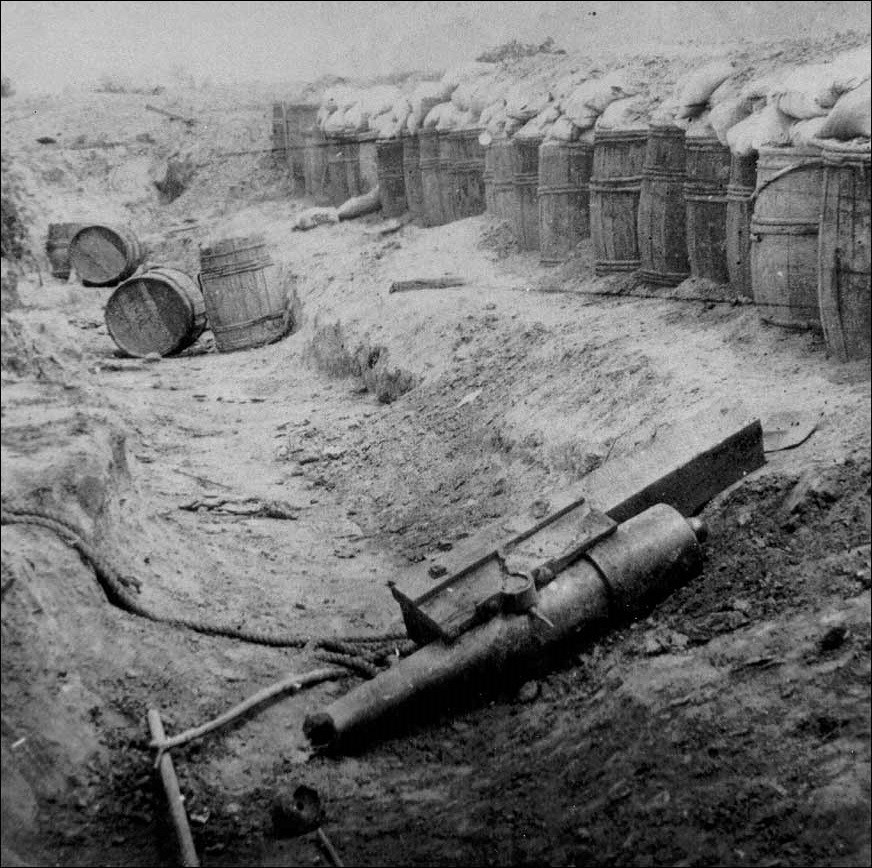
Photo 2: Confederate "rat holes" (dug-out caves) within the defensive lines. There was a Federal artillery position along the tree line in the distance.

Photo 3: A Confederate cannon demolished by Federal artillery fire. The earthworks include a barrel (upper left) with a hole for sharpshooting. This was nicknamed "Fort Desperate."
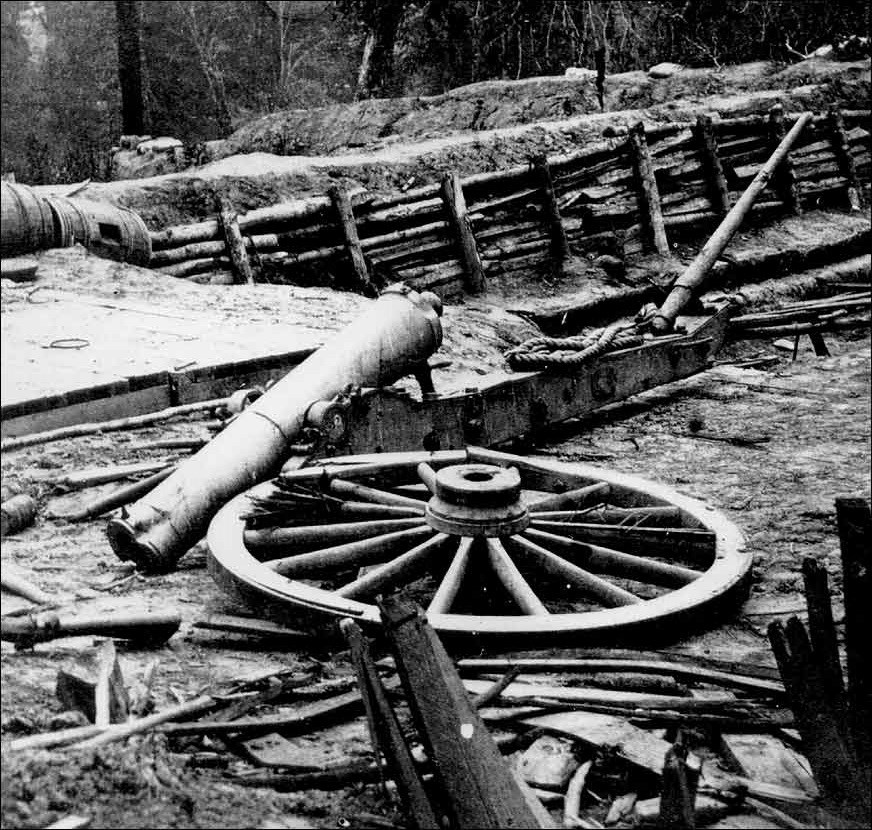
Photo 4: A gully used by Federal troops as a siege camp. The horizontal line at the base of the standing trees is a series of Confederate earthworks.
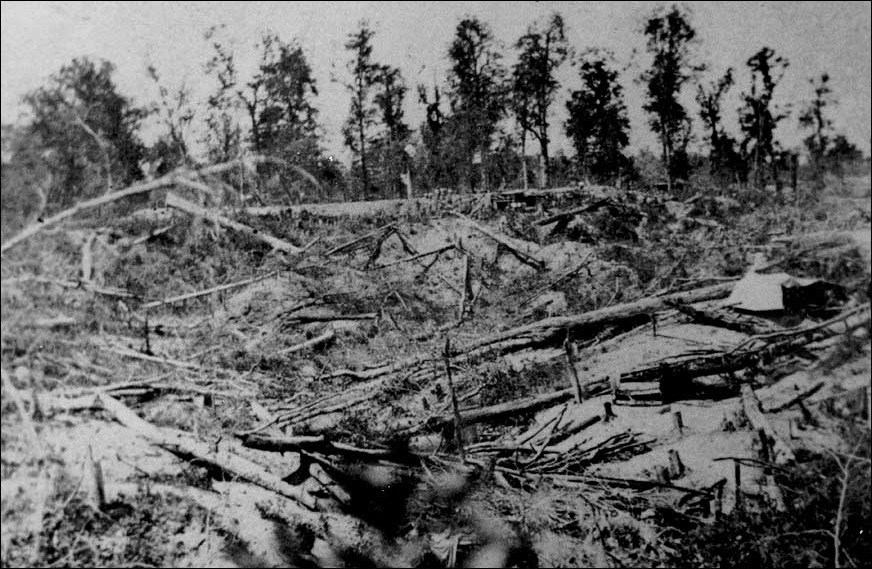
Photo 5: A Union artillery battery at Port Hudson. The white material in the foreground is cotton, bales of which were used to protect the cannoneers from Confederate fire.
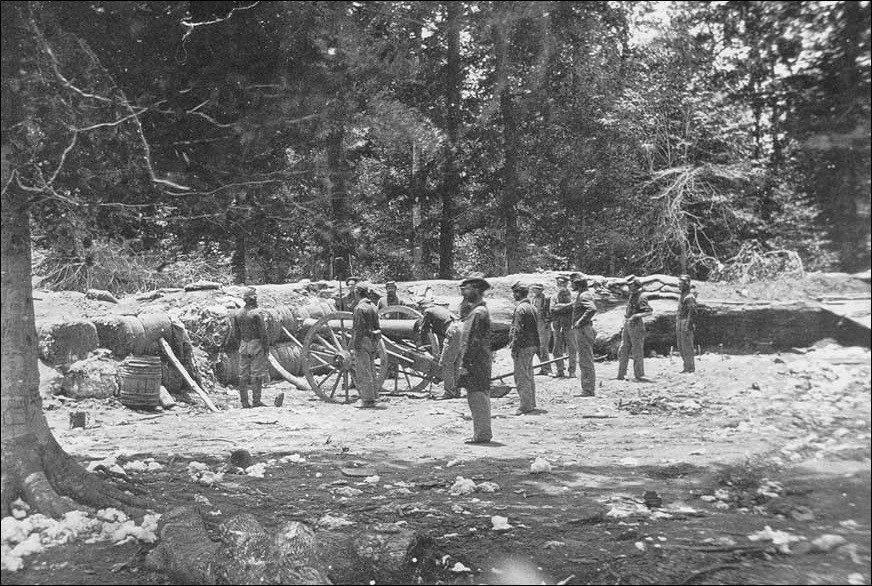
Photos 1-3 were made immediately after the Confederate surrender, and photos 4 and 5 were made during the siege.
The Civil War was the first major event in American history to be extensively recorded by photographers. The technology of the day allowed them to produce numerous copies of photographs; soldiers could then buy prints and send them to their loved ones. While newspapers then did not have the technology to publish photos, they often featured artists' drawings made from photographs. Together photos and sketches gave civilians at home an opportunity to see firsthand the destruction and devastation that war caused. This greatly affected public opinion on the war and the way it was being fought.
Questions for Photos 1-5
1. What methods did the Confederates use to defend their position?
2. What methods did the Union use to protect themselves and to make the Confederates submit?
3. Which reading does Photo 4 recall? Why?
4. Which photograph best helps you understand the atmosphere of a siege? Why?
Visual Evidence
Illustration 1: The charge of the
African-American troops at Port Hudson.
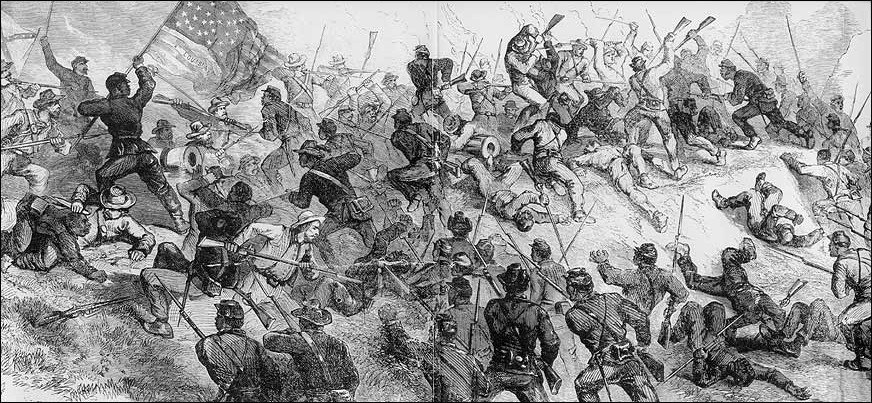
On May 27, 1863, the Union army's African-American troops charged against the Confederate earthworks. Although the artist wrote "2nd Louisiana" on the flag, the units were in fact the 1st and 3rd Louisiana Native Guards.
Questions for Illustration 1
1. Modern research indicates that the Confederates, in fact, suffered no casualties during this action. Casualties among African-Americans, however, were high. How does that information compare with the version of the attack that the drawing presents?
2. What is happening in this drawing? Why would someone create an inaccurate picture of the scene? Who might benefit from this version of the siege?
3. This drawing, and supporting newspaper accounts, helped change the opinions of the fighting abilities of African-American soldiers. Considering the conditions many African-Americans endured before the war, what may have been the impression the general public had of African-American fighting capabilities? How might illustrations such as this one change general public perception?
Putting It All Together
Activity 1: The Hero
Pvt. Henry Johns of the 49th Massachusetts Infantry (the author of Reading 3) won the Medal of Honor for his actions at Port Hudson. Although Johns' courage was recognized, many heroic acts go unrecorded or unrewarded. Have students interview a local veteran about special acts of bravery he performed or witnessed when he was a soldier. Have students include in their interview questions about the conditions under which the act was performed, the events leading up to this act, why the person who showed bravery did so, and whether the act was honored by a medal. Have students record their interviews in written reports, audio tape, or video. Place the results in the local library so that the veterans' actions will not be forgotten. Then students should write a brief summary of what they have learned, to which they should add a statement about whether they think the act was heroic and explain why or why not.
Activity 2: Debating Siege Warfare
Have students discuss the differences between siege warfare and open, or “regular,” battles. What makes siege warfare so horrible for those who are experiencing it?
Activity 3: Your Community Under Attack
Ask students to determine if their community has ever been involved in warfare--the Seven Years' War, Revolutionary War, Civil War, or some other conflict. If so, have them determine the military strategies employed during the battle. Was the community involved in a siege? If so, why was this strategy used? If not, what methods were used?
If the community has not suffered directly from warfare, form groups of students to explore severe natural or social pressures that the community has endured--floods, hurricanes, drought, riots, etc.. What were the similarities and differences between the stress of siege warfare and other kinds of severe pressures? What physical evidence remains in the community of the incident? Is this incident documented or commemorated, or has the community generally forgotten it? Students should prepare a "historic marker" that documents the incident and display it for general class discussion.
The Siege of Port Hudson: "Forty Days and Nights in the Wilderness of Death"--Supplementary Resources
By looking at The Siege of Port Hudson: "Forty Days and Nights in the Wilderness of Death," students can get a better understanding of siege warfare and how it affected the soldiers mentally and physically. Those interested in learning more will find that the Internet offers a variety of materials.
Library of Congress
The Library of Congress created a selected Civil War photographic history in their "American Memory" collection. Included on the site is a photographic time line of the Civil War covering major events for each year of the war.
Louisiana State Museum
The Louisiana State Museum web page offers a thorough account of Louisiana and its role in the Civil War. "Search" the museums web site for descriptions of Louisiana's key role in the war, histories on Port Hudson, and African-Americans soldiers in gray and blue. Also available is a Louisiana State Museum Map Database that has several maps of Port Hudson and its defences during the siege.
The Valley of the Shadow
For a valuable resource on the Civil War, visit the University of Virginia's Valley of the Shadow Project. The site offers a unique perspective of two communities, one Northern and one Southern, and their experiences during the American Civil War. Students can explore primary sources such as newspapers, letters, diaries, photographs, maps, military records, and much more.
For Further Reading
Students (or educators) wishing to learn more about Port Hudson and the Louisiana Native Guards may want to read the following: James G. Hollandsworth, Jr., The Louisiana Native Guards: The Black Military Experience During the Civil War (Baton Rouge, LA: Louisiana State University Press, 1995).
Tags
- civil war
- civil war battlefield
- african american history
- military history
- port hudson
- louisiana
- louisiana history
- national register of historic places
- nrhp listing
- teaching with historic places
- twhp
- civil war history
- african american soldiers
- military wartime history
- mid 19th century
- military wartime history
- mississippi river
- civil war fortifications
- twhplp
- cwr aah
